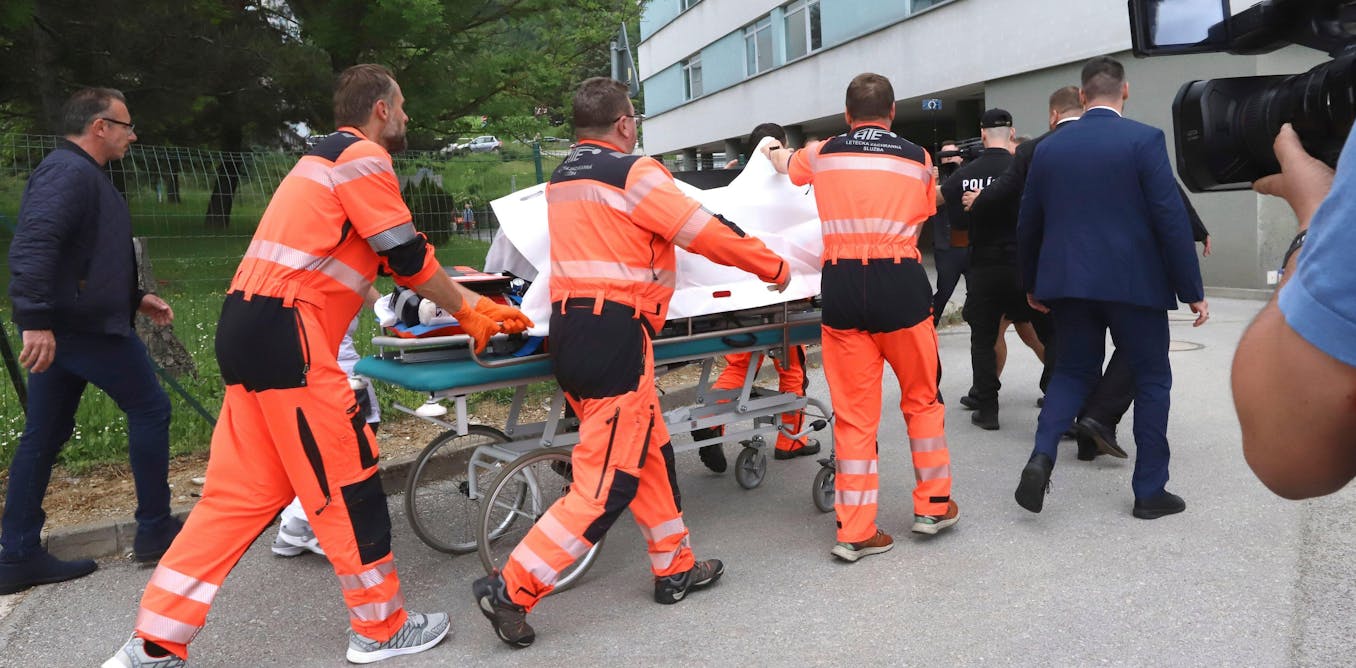Slovak society is in shock after a 71-year-old man fired five shots at the prime minister, Robert Fico, while he was greeting a small crowd after a meeting.
Some members of the coalition government immediately blamed the opposition and the media for encouraging anger towards Fico, who has been implementing reforms that threaten media and judicial freedom.
Fortunately, Fico has survived, but the fallout from the attack will nevertheless be severe. Many will be reminded that the repercussions of another murder, of reporter Ján Kuciak and his partner Martina Kušnírová in February 2018. It was this crime that set in course the chain of events that would make Fico the politician he is today.
Fico was prime minister at that time, too. But due to the fact that the murder investigation led dangerously close to his political circles, he was forced to resign.
In a wave of public indignation, lawyer Zuzana Čaputová, who wanted to fight against political corruption, decided to run for the office of president. In March 2019, to everyone’s surprise, she became the first female president in Slovak history. In the second round of these elections, she convincingly defeated the candidate of Fico’s centre-left Smer party.
Fico was humiliated by his forced departure and Čaputová’s victory, but he did not intend to give up and leave politics for good. He wasn’t even deterred when his own party split in two in 2020, with his former ally Peter Pellegrini leading the splinter party Hlas SD.
Alamy/AP
Fico is the most seasoned player in Slovak politics. He became prime minister for the first time in 2006 and the current administration is his fourth stint in the role. Until 2018, despite some reservations, he was not considered a politician tending to extremes. He was even prime minister when Slovakia joined the euro in 2009.
However, he began to radicalise more and more during his years in opposition. He increasingly criticised the investigation into Kuciak’s murder, the western orientation of his country and, above all, Čaputová as president.
It appears to have become clear to Fico that he would lose support from moderate Slovaks because of his extreme views, but he has been careful not to alienate either the far left or the far right. On one hand, he, personally, has roots in the communist party, and on the other, he has been cautious not to alienate the extreme right. Doing so would close the door to the possibility of future coalition cooperation.
By radically rejecting liberalism, Fico appeals to extremists from both the right and left. According to him, the real extremists are the people promoting membership of the European Union, Nato, and support for Ukraine.
Čaputová: an embattled president
In June of last year, Čaputová announced that due to the threats and abuse she and her family had endured, she no longer had the strength to continue in politics. She decided not run for a second term as president. But the timing of her announcement, a long time before the presidential contest and only a few months before parliamentary elections, appears to have been a strategic error.
Sensing an opportunity in the president’s weakness, Fico and Smer were able to win the parliamentary election, forming a new government coalition with Pellegrini’s Hlas SD and the extremely nationalist Slovak National Party.
Even now, as Fico lies in hospital, Čaputová remains in office. She is in the process of handing over to her successor – the very same Peter Pellegrini who was once part of Fico’s party. But he doesn’t begin in the role until June. Meanwhile, Čaputová must appeal for calm in Fico’s name.
Fico’s election victory on an illiberal platform and antagonism towards the president he was supposed to be working alongside at the time of the attack, combined with the centre-right’s failure to provide an alternative, has left Slovak society polarised to an unprecedented degree.
Paradoxically, it was Fico who predicted the consequences of all this most accurately. In a speech published on Facebook this April, he cast himself as victim and declared that he would not be surprised if the hatred towards him led to the murder of a government politician.
He has survived, but Fico has nevertheless become a martyr to “liberal tyranny” for his supporters – regardless of the fact that everyone, including all of Fico’s critics, have unequivocally condemned the attack.
The murders of Kuciak and Kušnírová remain unsolved. Solving the case of the failed assassination of the prime minister will apparently be much faster and easier, given that a man has already been charged.
However, it is more likely that efforts to point the finger across the political divide will dominate Slovakian discourse for the foreseeable future. And this will come at the expense of a full discussion about what factors led to this crisis in the first place, and how best to avoid them in the future.

